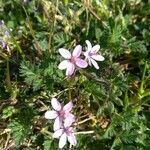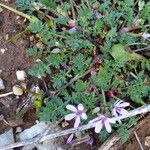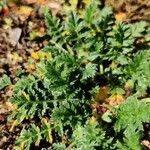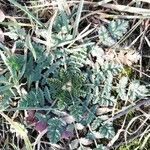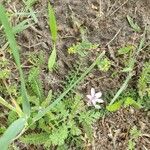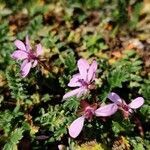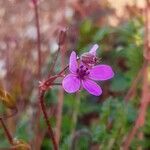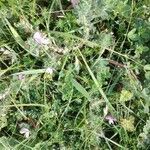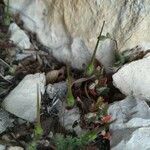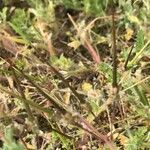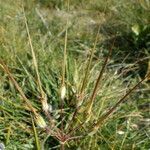Annual, at first stemless, later usually with 1 or more hairy stems; plant extremely variable in size, from prostrate to c. 50 cm high and c. 75 cm wide, not musk-scented. Lvs to c. 15 cm long, pinnate, hairy, sometimes densely so, sometimes glandular; petiole longer in rosette and lower cauline lvs. Leaflets sessile, ovate, deeply and finely pinnately dissected with linear to lanceolate lobes, often densely covered in white hairs. Stipules triangular, often broad, membranous, ciliate, silvery; midrib green, forming an acute or mucronate apex. Umbels (2)-5-12-flowered; bracts broad-ovate, membranous, with green keeled midrib forming an acute to short-acuminate apex. Peduncles densely covered in glandular hairs, often > upper cauline lvs; pedicels ± = calyx at anthesis. Sepals (2.5)-3-5 mm long at anthesis, lanceolate, hirsute or glandular, mucronate. Petals 4-6 mm long, elliptic or oblong-elliptic, usually pink or mauve-pink, rarely white; claw short, hairy. Stamens c. 3 mm long; filaments widened at base, without lateral teeth, usually pinkish; anthers dark purple. Staminodes narrow-lanceolate. Fr. beak 3-3.5 cm long, with appressed hairs. Mericarps densely hirsute with hairs of differing lengths; apical pits eglandular, with a prominent shallow glabrous furrow beneath.
Annuals 10-15(-40) cm tall. Stems numerous, erect to decumbent. Stipules triangular-lanceolate, 2-6 mm. Leaves opposite or alternate; leaf blade triangular-lanceolate to oblong-lanceolate, 5-18 cm, pinnately divided to pinnately cleft, 5-12-lobed with basal ones more deeply incised, both surfaces appressed pilose. Pseudoumbels conspicuously longer than leaves, with (2 or)3-10 hermaphrodite flowers; peduncle with glandular and nonglandular trichomes. Pedicel 0.8-1.7 cm. Sepals ovate, 3-6 mm, glandular and hirsute, apex acute. Petals uniformly purple or 2 with a basal black spot, obovate, 5-12 mm. Mericarp 3-7 mm, with apical pit, with or without ridges or furrows; awn not plumose. Fl. Jun-Jul, fr. Jul-Oct. 2n = 20, 36, 40, 48, 54.
Winter-annual or biennial; stems at first anthesis very short, with the lvs mostly basal, later diffusely branched, to 4 dm; lvs elongate-oblanceolate, the principal ones pinnately compound with several sessile, ovate or oblong, deeply and irregularly cleft pinnae each 1–2.5 cm; infls long-peduncled, 2–8-fld, the pedicels 1–2 mm; sep 5–7 mm, mucronate or shortly awned; pet off-pink, 5–8 mm; anther-bearing filaments without teeth; fr 2–4 cm; 2n mostly = 40 in ours. Native of the Mediterranean region, now established as a common weed throughout most of the U.S. Apr.–Sept.
Annual, hairy herb, up to 0.5 m long. Stems procumbent. Stipules 2, ovate, apex acuminate, pinkish to straw-coloured. Leaves rosulate or caulescent, subopposite or opposite, petiolate; lamina carrot-like, ovate to elliptic, pinnate, pinnae pinnatifid, divided for more than half-way to midrib. Inflorescences up to 10-flowered; peduncles 17-20 mm long; pedicels 5-7 mm long. Petals purplish pink to whitish. Flowering time all year. Mericarps with eglandular apical pits, tail 10-70 mm long.
Annual herb; pubescent. Stems procumbent, up to 0.5 m long. Leaves rosulate and caulescent; compound; alternate or opposite; petiolate; blade ovate to elliptic, 45-115 x 15-35 mm, pinnate, pinnae deeply lobed, margins serrate to dentate; petioles up to 150 mm long. Flowers: in umbels with up to 10 flowers; peduncles 17-20 mm long, pedicels 5-7 mm long, reddish purple; fertile stamens 5, staminodes 5; petals 4-10 x 2-3 mm, purplish pink to whitish; Jan.-Dec. Fruit 4-7 mm long.
Annual herb, with prostrate, hispid to hirsute stems, up to 500 mm tall. Leaves ovate to elliptic, pinnate or often bipinnate, leaflets always divided for more than halfway to midrib. Flowers up to 10 per inflorescence, purplish pink to whitish. Year-round.
